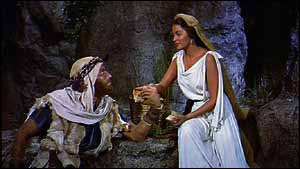|
THE GREATEST EVER JEWISH FILMS Greatest Passover film drained of Jewish content | |
Since then films as diverse as When Do We Eat?, Jews in Space, The Governess and Schindler's List have all featured the seder. A Family Affair even reinvents Passover as a "festival freedom for all our GLBT ( Gay, Lesbian, Bisexual and Transgender ) loved ones". Although it is not explicit in Steven Spielberg's Munich, Passover is referenced via a midrash about the Exodus from Egypt. In Capturing the Friedmans, a documentary charting the decline of a Jewish family when the father, Arnold, and youngest son, Jesse, are accused of sexually abusing dozens of young boys who came to the Friedman home for computer classes, traditional Jewish family scenes, in particular the seder, serve as the backdrop to the crumbling family's last weeks together, as captured on 8mm videotape. Finally, Spielberg's animated The Prince of Egypt was released in 1998. But perhaps the greatest Passover film of them all is Cecil B De Mille's The Ten Commandments (1956). De Mille took his 1923 prototype and enlarged it into an epic of Biblical size. Where it had been merely two-strip black and white, it was now in glorious full three-strip Technicolor; where it had been silent, it was now in full stereophonic sound; and where it had been 35mm it was now in full 70mm widescreen VistaVision. Only now did De Mille possess the technology and vast financial resources (the $12m budget for The Ten Commandments broke the all-time spending record for a film at that time) to be able to bring the Bible to life. And it proved to be popular too, making an astonishing $43m; it is the only religious epic film that is regularly broadcast on US television during the Passover and Easter holidays each year. Yet, the film was drained of almost any specifically Jewish content and this was particularly evident in its promotional materials. "The Most Significant Human Drama Ever Lived!" proclaimed the film's poster. "Cecil B De Mille has recorded, for all ages, the dramatic story of Moses and the Ten Commandments, bringing to life through the medium of the motion picture screen, this inspiring theme." Nowhere was the specifically Jewish/Hebrew nature of the story mentioned. Released in the midst of the early Cold War, the film could not help but allude to its context. In the film's opening narrative, De Mille described it as "the story of the birth of freedom". He then identified this freedom with the American struggle during the Cold War: "The theme of this picture is whether men ought to be ruled by God's law or whether they are to be ruled by the whims of a dictator like Rameses. "Are men the property of the state or are they free souls under God? This same battle continues throughout the world today." The film's values are undeniably Western. The Middle East is reconstituted as the Middle West and the Promised Land is conflated with the United States as a 'city on the hill'. Charlton Heston, as Moses, is even posed to resemble the Statue of Liberty as he carries the two tablets. Although the Jewish origins of The Ten Commandments were replaced by a Cold War ideology that rendered Passover intelligible to a wider American audience, it's still an 'inspiring' film and one yet to be bettered when it comes to Pesach. Nathan Abrams is a senior lecturer in film studies at Bangor University and is the author of The New Jew in Film: Exploring Jewishness and Judaism in Contemporary Cinema (IB Tauris, 2012).
|
 SHEPHERD TRAINING: Sephora (Yvonne De Carlo) teaches Moses (Charlton Heston) how to tend sheep in Midian in The Ten Commandments
SHEPHERD TRAINING: Sephora (Yvonne De Carlo) teaches Moses (Charlton Heston) how to tend sheep in Midian in The Ten Commandments